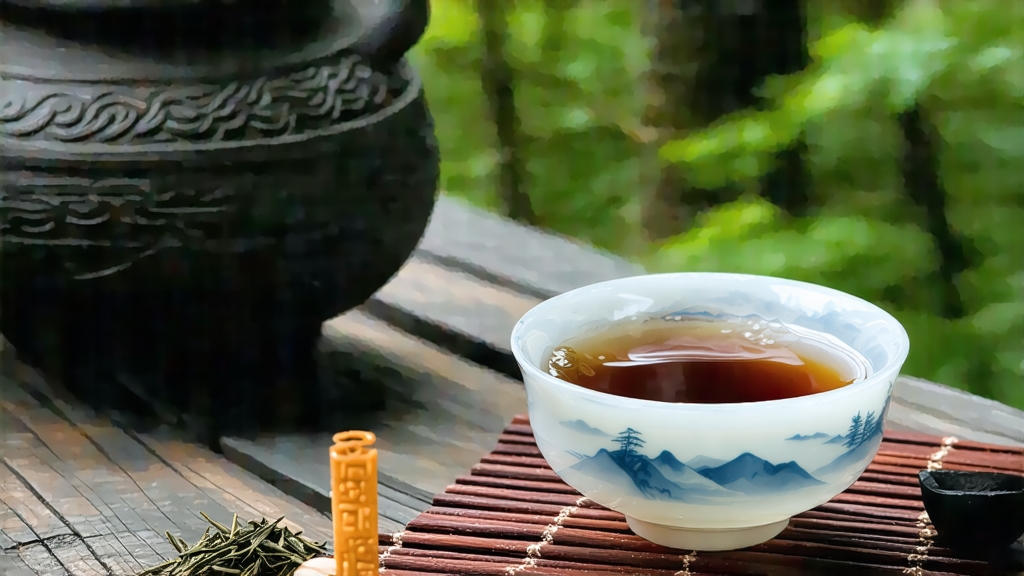
Long before Assam, Ceylon or Darjeeling entered the lexicon of tea, a small village deep in China’s Wuyi Mountains produced a leaf so radically different that Dutch traders in the early seventeenth century coined a new word for it—“bohea,” their corruption of “Wuyi.” That leaf was Lapsang Souchong, the first fully oxidised tea ever created and the prototype for every black tea on earth today. To international drinkers raised on the malty sweetness of Assam or the wine-like muscatel of Darjeeling, Lapsang can seem almost anarchic: a tea that smells of campfire and leather, yet finishes with cocoa-like sweetness and the cool minerality of a mountain spring. Understanding its story is to understand how Chinese ingenuity, geography and commerce collided to give the world a completely new beverage category.
Origin and legend
Tongmu Guan, a protected enclave inside the Wuyi UNESCO World Heritage site, sits at 27° north latitude where mist rising from the Jiuqu (Nine-Bend) River wraps the cliffs 200 days a year. The micro-climate—cool, humid, pine-scented—creates ideal withering conditions and imparts the resinous aroma that defines Lapsang. Local folklore credits an army unit passing through in 1567–68 who commandeered fresh green leaves for bedding; by the time they left, the leaves had turned red under the summer sun. Frugal farmers dried the half-fermented leaf over available pinewood to “save” it, inadvertently discovering that smoke fixed both flavour and shelf life. Whether apocryphal or not, the tale underscores two constants: accident and pine.
From the late Ming onward, Lapsang travelled down the Min River to Xiamen (then Amoy), where clipper ships of the Dutch and later the British East India Company loaded chests labelled “Souchong”—a Cantonese term meaning “small sort,” the fourth and smallest leaf on the tea bush. By 1669 the British tariff code listed “Bohea Tea” as a separate commodity from green teas, and Catherine of Braganza’s dowry helped make it fashionable at the Stuart court. Thus the first “red tea” (hong cha) that Chinese farmers called zhengshan xiaozhong entered English vocabulary as black tea, a linguistic inversion that still confuses newcomers.
Terroir and cultivar
True Lapsang Souchong can only be called zhengshan (“original mountain”) if grown inside the 600 km² core zone around Tongmu. The soil is weathered tuffaceous rock rich in potassium and manganese; drainage is so sharp that roots plunge two metres searching for water, concentrating amino acids. Two indigenous cultivars dominate: Xingcun Xiaozhong (small-leaf) and Cai Cha (mixed colour), both descendants of ancient Wuyi shrub tea. Their leaves are unusually thick, with a waxy cuticle that withstands heavy smoking without turning acrid. Above 800 m elevation, spring arrives two weeks later than in nearby valleys, so April plucking coincides with the resinous peak of local Masson and Huangshan pines.
Craft: the four pillars of pine-smoke
Unlike modern black teas that rely on mechanised oxidation, authentic Lapsang is still hand-made in 25 kg batches using four sequential stages that can stretch 30 hours.
-
Withering over pine embers
Fresh leaves are laid on bamboo trays set one metre above a dying pinewood fire. The heat is gentle (30–32 °C) but the smoke is copious; doors and windows are sealed so that phenols and creosote permeate the leaf. Craftsmen “read” the surface tension of the leaf every 20 minutes, turning trays to ensure even exposure. This step both dehydrates and impregnates the leaf with guaiacol and syringol, the molecules responsible for the characteristic smoky note. -
Rolling by hand
Once the leaf is limp enough to knot without tearing, two workers stand on opposite sides of a bamboo tray and roll the leaves in alternating clockwise and counter-clockwise motions. The goal is to rupture 70 % of the cell walls without macerating the leaf, releasing catechins that will oxidise into theaflavins and thearubigins. A faint coppery aroma signals readiness. -
Oxidation in pine